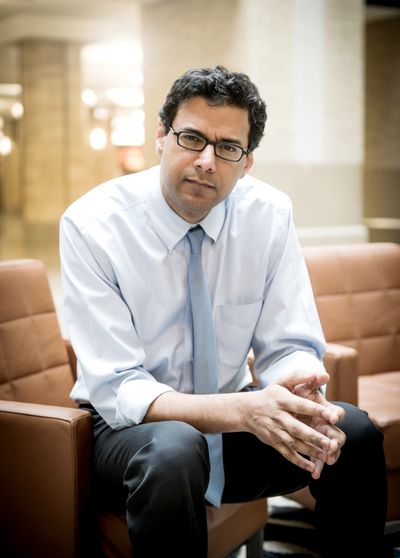Doctor’s book tackles realities at end of life

It may be the fact that Atul Gawande is a doctor – a Harvard doctor, yet – that draws readers to his books on our flawed medical system.
But he wouldn’t make the best-seller lists if he wrote like most doctors.
This is a guy with one of those renaissance-man résumés that makes even quite accomplished people look like slackers. Stanford undergrad. Rhodes scholar studying philosophy. Health-care adviser to President Bill Clinton. Medical degree and master’s in public health from Harvard. Writer of four books and many New Yorker articles. MacArthur fellow. Surgeon. Founder of a lab that studies health quality. Now, after working on a PBS Frontline segment on his book, he’s learning filmmaking. He’s 49.
What seems to hold all that together is, obviously, a fine brain, but also relentless curiosity, an eye for story, and an attraction to complex problems. What sets him apart as a writer is his ability to make what he’s learned seem simple. Or at least simpler.
His latest topic – aging and dying in America – is immense. “In Being Mortal: Medicine and What Matters in the End,” Gawande tackles the joyless way many people live in their later years and the excesses of medicine that many endure in their final months and days. The 263-page book interweaves stories about his own family and patients with reporting on how we die, trends in housing for the elderly, and the value of geriatricians and palliative-care specialists.
Gawande spoke recently to about 2,500 doctors and nurses at a joint meeting of the American Academy of Hospice and Palliative Medicine and the Hospice and Palliative Nurses Association at the Pennsylvania Convention Center.
The book is selling well – it’s the No. 1 nonfiction title on the New York Times best-seller list – but it is unlikely much of what Gawande says in it will be news to this crowd. Asked by phone what he would tell the pros, Gawande laughed and said he was still figuring that out.
“At one basic level,” he said, “it’s, ‘Thank you, and why the hell aren’t people listening to you?’ ”
Gawande’s book, which includes some material previously published in the New Yorker, is partly a personal journey: A doctor discovers he has been seeing only a fragment of the medical picture as his wife’s grandmother declines with age and his father, also a physician, copes with a fatal cancer.
Gawande the surgeon has focused on keeping people alive. As he explores what aging and disability are really like, he sees that he has shied away from talking with his patients honestly about the problems he can’t fix.
Asked how someone steeped in medicine and health policy could have been so naive, he referred to the first line of the book: “I learned about a lot of things in medical school, but mortality wasn’t one of them.”
Many doctors go into medicine because they like the idea of saving people, he said. He did, too, but he was soon troubled by suffering he was unable to relieve.
Still, his perspective was limited. “Your glimpse of people’s lives is the glimpse you get in a 30-minute office visit,” he said. “That’s not their real life.”
Researching the end of life like a reporter took him into houses, nursing homes, and assisted-living facilities, places where most doctors don’t go. Seeing firsthand the tough decisions his family had to make added to the picture.
“I’d not seen what it was like to be the husband dealing with the wife who couldn’t eat anymore,” he said, “or the daughter with the father who’s become a quadriplegic.”
He had set out to write about the end of life but realized the need for better communication about what people want and need starts much earlier, as age and debility begin to erode independence. Their children want them to be safe, Gawande said, but what older people want for themselves – what we all want for ourselves – is autonomy and a sense of purpose.
These attitudes should have been entwined in medical decision-making, but they weren’t. Faced with choosing among eight or nine chemotherapy regimens for his father, Gawande realized he needed more information. How would each affect his father’s desire to maintain mental clarity and function? Ultimately, his father’s condition declined, and he had no chemo at all. Soon, it was time for hospice.
If there’s one message Gawande would want people to take from the book, it is that doctors need to talk to their patients, and we need to talk to our families about what really matters at the end. “People have priorities beyond just living longer, no matter what,” Gawande said. Those priorities vary. “The most reliable way of knowing is to ask them.”
Gawande is big on checklists as a way to reduce errors in complex care. So, of course, he asked experts on patient communication for key actions to check off.
One of the suggestions that stuck with him is to talk less than half of the time while he’s with a patient. He was horrified to learn he was talking close to 90 percent of the time.
Once he talked less, he saw what patients need is “some opportunity to explain themselves, what their fears are … what they’re willing to sacrifice, what they’re not willing to sacrifice.”
He has become more comfortable with the topic and is hopeful others will too as more people witness hospice and palliative care.